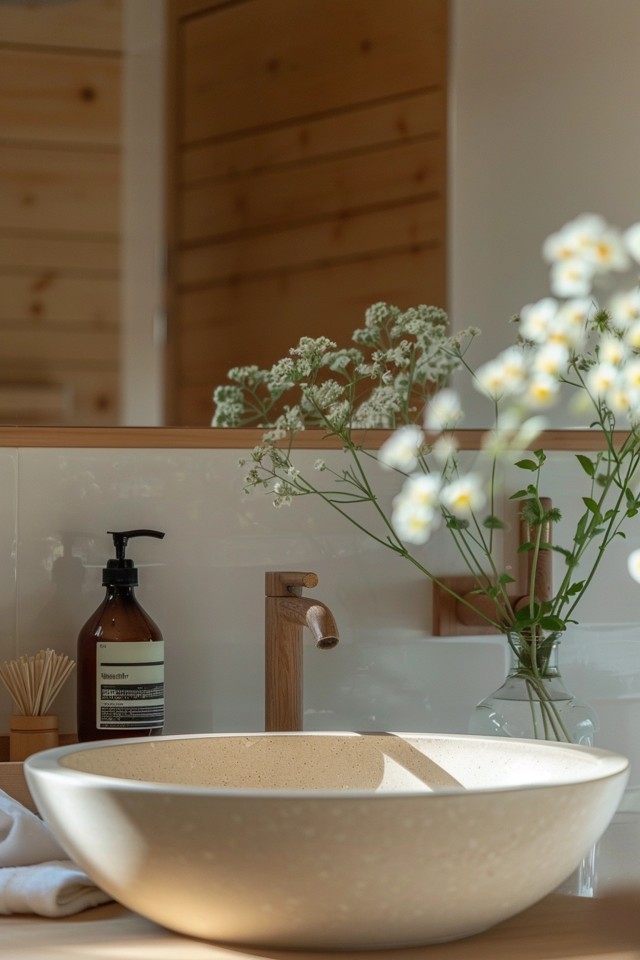In today’s fast-paced world, creating a calm and peaceful sanctuary within our homes has become more crucial than ever. When it comes to bathroom design, the Japandi style offers the perfect blend of minimalism, tranquility, and modern aesthetics. Combining elements of Japanese and Scandinavian design, Japandi bathrooms bring together clean lines, neutral color palettes, natural materials, and a sense of zen inspiration.
The Japandi design philosophy revolves around simplicity and creating a space for relaxation and rejuvenation. By incorporating minimalist bathroom design principles, a neutral color palette, and natural elements, you can transform your bathroom into a serene oasis.
Key Takeaways:
- Japandi design combines Japanese and Scandinavian aesthetics for a harmonious and minimalist bathroom style.
- Neutral color palettes evoke tranquility and can be achieved through shades of beige, taupe, soft greens, and muted blues.
- Incorporating natural elements like wood, stone, and bamboo enhances the overall Japandi aesthetic and promotes a calm atmosphere.
- A minimalist bathtub can serve as a focal point in a Japandi bathroom, symbolizing relaxation and rejuvenation.
- Functional storage solutions and low-level ambient lighting contribute to the clean and simple aesthetics of a Japandi bathroom.

Designing for Serenity: Neutral Color Palettes Explained
Creating a serene and peaceful atmosphere is essential when designing a Japandi bathroom. One of the key elements that contribute to this sense of tranquility is the use of neutral color palettes. Incorporating colors inspired by nature, such as shades of beige, taupe, soft greens, and muted blues, can instantly evoke a feeling of calmness and serenity.
The concept of wabi-sabi, deeply rooted in Japanese culture, embraces the beauty found in imperfections. This philosophy aligns perfectly with the neutral color palettes used in Japandi bathrooms. The subtle variations in shades and hues found in natural colors reflect the authenticity and simplicity of wabi-sabi.
“Neutral colors reflect the Japanese concept of wabi-sabi, embracing beauty found in imperfections.”
By choosing neutral colors for both the walls and accessories in your Japandi bathroom, you can create a harmonious and balanced space that promotes relaxation and mindfulness. These colors provide a blank canvas that allows you to focus on the present moment and embrace the tranquility of your surroundings.
Furthermore, neutral color palettes complement the clean and simple aesthetics of Japandi design. They enhance the minimalistic approach by creating a visual flow and a sense of coherence throughout the space.
Whether it’s a warm beige tone reminiscent of sand on a beach or a soft green shade that reflects the tranquility of a forest, neutral colors play a vital role in establishing the serene ambiance that is characteristic of Japandi bathrooms.

Key Takeaways:
- Neutral color palettes are essential for creating a serene and peaceful atmosphere in a Japandi bathroom.
- Inspired by nature, neutral colors such as beige, taupe, soft greens, and muted blues evoke a sense of tranquility.
- Neutral colors reflect the Japanese concept of wabi-sabi, embracing beauty found in imperfections.
- Choosing neutral colors for bathroom walls and accessories promotes relaxation and mindfulness.
- Neutral color palettes complement the clean and simple aesthetics of Japandi design.
By incorporating neutral color palettes into your Japandi bathroom, you can create a space that fosters tranquility and promotes a sense of harmony and balance. Achieve serenity through the simplicity of neutral colors and embark on a mindful journey in your rejuvenating oasis.
Creating a Focal Point with a Minimalist Bathtub
In Japanese culture, bathing holds great significance and is seen as a ritualistic and meditative practice. The Japandi bathroom design draws inspiration from this Japanese bathing culture, where the bathtub becomes the focal point of the space.
A minimalist bathtub with clean lines and a sleek design is key to achieving the Japandi aesthetic. It creates a sense of tranquility and serenity, symbolizing relaxation and rejuvenation. This minimalist bathtub represents a sacred space for cleansing the body, mind, and soul, fostering a deeper connection to oneself.
When selecting a bathtub for your Japandi bathroom, it is important to consider the material, shape, and size that best fit the space and your personal preferences. Materials such as stone, concrete, or composite with a matte finish are ideal for achieving a minimalist design.
By incorporating a minimalist bathtub as the centerpiece, your Japandi bathroom will exude a sense of calm and provide a sanctuary for self-care and introspection.

Key Takeaways:
- The bathtub is the focal point in a Japandi bathroom, drawing inspiration from Japanese bathing culture.
- A minimalist bathtub with clean lines creates a sense of tranquility and symbolizes relaxation and rejuvenation.
- Consider the material, shape, and size of the bathtub to achieve the desired minimalist design.
Embracing Natural Elements and Accessories
Incorporating natural elements and accessories is a fundamental aspect of Japandi bathroom design. By utilizing materials like wood, stone, bamboo, and organic fabrics, you can establish a strong connection with nature, fostering a serene and calming environment. These natural elements not only add warmth and beauty to your bathroom but also introduce various textures that enhance the overall aesthetic.
One effective way to infuse nature into your Japandi bathroom is by incorporating plants. Not only do they embody the essence of Japandi design, but they also improve the air quality and contribute to a stress-free atmosphere. Integrating different plants and greenery not only enhances the visual appeal but also creates a harmonious connection with nature.
Textures play a crucial role in Japandi bathroom design, allowing you to add depth and visual interest to the space. Utilizing Rough stone tiles, smooth wooden surfaces, and woven bamboo accessories can bring unique textures that elevate the overall design. These elements create a tactile experience, making your bathroom feel inviting and cozy.
Another way to enhance the coziness and comfort of your Japandi bathroom is by layering textiles. Soft towels, bath mats, and rugs add a touch of luxury while providing comfort and warmth. Opt for organic materials like cotton or linen to maintain the organic theme of your bathroom.

